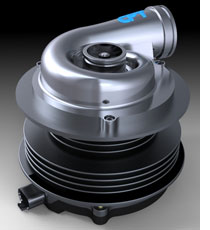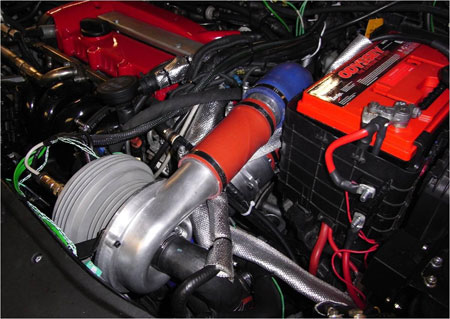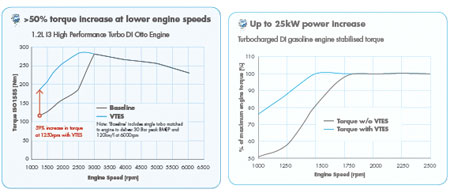 For the longest time we’ve known the most common method of forced induction to be either supercharging or turbocharging. Supercharging uses a compressor that’s powered by the engine crank while a turbocharger uses the kinetic energy harvested from the flow of exhaust gas to do the same thing.
For the longest time we’ve known the most common method of forced induction to be either supercharging or turbocharging. Supercharging uses a compressor that’s powered by the engine crank while a turbocharger uses the kinetic energy harvested from the flow of exhaust gas to do the same thing.
A company called Controlled Power Technologies is offering something new called a VTES, or Variable Torque Enhancement System. It’s basically an electric supercharger. There are alot of people who try to install fans in the middle of the car’s intake tract and try to call it a supercharger, but this is a proper compressor that can spin independently of crank speed at rotational speeds of up to 70,000rpm.
CPT has installed it on various test systems including a 1.2 litre turbocharged engine. The VTES electric supercharger is meant to complement the existing turbo. CPT reported an increase of over 50% in torque at engine speeds below 3,000rpm. I guess what it does is compensate for any turbo lag there is at low engine RPMs, allowing the turbocharger to be larger than it normally would have needed to be to spool up that quickly.

VTES electric supercharger on an AVL demo engine
One way that VTES has been positioned by CPT is an alternative to mild hybrid systems, like the units installed in the Honda Civic Hybrid and the Kia Forte LPI Hybrid. According to CPT senior engineering manager Mark Criddle, one method that car makers have been using to boost performance of downsized engines is integrating an electric motor between the engine and transmission to create a mild hybrid, but this is a costly exercise and can be difficult to package within a small car’s front wheel drive engine bay.
The VTES system can provide a viable low cost micro-hybrid solution, significantly increasing an engine’s air charge density over the critical first 10 combustion cycles of a low speed transient. The supercharger’s speed can increase from zero up to 70,000rpm in less than 1/3 of a second. Adding 25kW at the crank at low engine speeds via VTES costs significantly less than a 25kW assist electric motor. It uses standard 12V power.

Left: 1.2L turbo inline-3 direct injection engine
Right: 2.0 litre turbo inline-4 direct injection engine
It will be featured in the HyBoost system, a project led by Ricardo and supported by the UK government’s Technology Strategy Board. It will also be used in an engine project by AVL. AVL is an Austrian-based independent engine developer. The 1.6 litre engine that you can find in the Chery Tiggo here in Malaysia was developed by AVL and they are actually pretty good. Some time ago there was news that Fiat was interested in using Chery’s AVL-designed ACTECO family engines in Fiat cars in China.
AVL previously showcased a demonostrator engine using CPT’s electric supercharger. A 2.0 litre inline-4 direct injection engine was equipped with a regular single-scroll wastegated turbocharger, and CPT’s VTES electric supercharger. It resulted in 200 PS and 400Nm of peak torque. The engine also has auto stop-start and smart alternator control. They installed it into a Volkswagen Passat and the resulting CO2 emissions were 159g/km. Comparatively, the Passat’s original 200 PS 2.0 TSI petrol and 170 PS 2.0 TDI diesel engines gave out 194 g/km and 165g/km respectively.
Looking to sell your car? Sell it with Carro.






Why do i get a feeling that superchargers are like overclocking a pc?
Getting all that power with the same capacity of the engine feels like somewhat "cheating"
May we be enlightened on the down-side of charging?
Higher fuel consumption?
More frequent maintenance?
our car is actually 70-80 % of its potential
squeeze some ponies will take out some miliseconds in a sprint
Maybe someone will get an idea to place this in their Exora
Supercharging or "over clocking" your pc is not cheating. Its just science. More air, more fuel, more power.
Overclocking yes but higher FC no cos it gives more boost at lower RPM.
Yes the downside is whether the engine/crankshaft/gearbox can withstand
the higher temperature generated = may hv to add an intercooler
,use only synthetic oils etc
Our start and drive habits hv2be changed too cos the supercharger needs
warming up but unlike a turbochager it does not need cooling down(no turbo timer req.)
Would this device resolve the annoying torque dip of the CAMPRO ?
Supercharger for sure will solve torque problem and even increase all the output!
The problem now is the electric motor, how long can it last?!? Compare to mechanical which only need to be driven by a belt and pulley?
Forced induction systems be it turbocharger or supercharger (mechanical or electric) simply increases the combustion chambers' volumetric efficiency. It simply drives more air through the engine. In effect like having a bigger cc engine but minus the extra weight and friction.
In principle it does not improve the engine's thermal efficiency, which hasn't improved much for decades.
Intercoolers simply improve volumetric efficiency further in addition to other benefits associated with lower gas temperatures.
Just remember the lessons in your Thermodynamics class.
There is no such thing as a 'free lunch'. Superchargers and turbochargers all consume energy from the engine to increase engine output.
Mechanical superchargers 'consume' some of the mechanical energy output from the engine. Parasitic losses. If electric, energy is stored before consumption but it's still consumed from the engine's mechanical output, via alternator to charge the supercharger battery.
Turbochargers in theory can improve the thermal efficiency of the engine, depending on application. This is because there are no 'parasitic losses'. It does not consume any mechanical output energy from the engine. In fact it recycles energy otherwise wasted as heat through the exhaust.
The turbo actually converts wasted heat energy(more than kinetic energy) from exhaust and turns it into useful mechanical work to force more air into the engine. Under certain conditions at constant rpm the turbo charged engine is more fuel efficient than it's NA equivalent producing the same power.
Electric supercharger simply allows more flexible boost control
@diablo
nice lecture.
So, in essence, turbocharger is the free lunch?
Not all of us took thermodynamics class.
More frequent maintenance is needed on supercharged cars due to the extra wear and tear from the extra power?
Pardon my ignorance of the science.
khimfoh said,
September 23, 2009 @ 6:03 pm
I thought Proton has resolved the torque dipping problem with the introduction of IAFM module in Campro engine. As for Campro CPS, its already a powerful engine, no IAFM module is required.
Unfortunately, they're some issues on the quality of these local car parts. Heck almost on all of Proton and (Perodua too) products! For as long it is manufactured by our good local vendors, Malaysians will never see the full potential of QC/QA products from them! Long live imported cars!
hopefully this tech will install at campro engine !!!!
@diablo..very nice lecture, simple & constructive :)
@wen..i think there is no free lunch.
1. although turbochrgd engine uses exhaust flow (flow is due to pressure difference), there is limitation at what flow the turbine (air compressor for turbochrgd) will work efficiently.
in other words, exhaust flow (pressure) must be well determined so that turbochrgd engine will work at best.
2. wear & tear will always be there, now or later.
3. either tubochrgd or superchrgd has its own pro&con.
i'm not that well versed in these types. hope diablo will explain more :)
how about a superchager kit for the Myvi 1.3?? but the cost must be cheap2 haha….
what the point really? Its not like this thing is in M'sia? Pffttt…! Another pointless entry!
Like what Orido said – this gadget is very unlikely to reach KL shores. And even if it does, it'll probably be more cost effective to do a turbo engine replacement.
Good concept tho. Interestingly, the same company is coming up with a electricity generator that is run by exhaust gases. Imagine you paid that with this electric supercharger, exhaust gas runs the electricity which powers the SC which gives the car more power which gives more exhausts that runs the electricity, etc.
Pretty neat concept.
"paired" not "paid". Sorry.
50% more torque by just bolting on the compressor? Any other adjustment like fuel injection, timing etc? If no extra fuel and 50% more torque, why it isn't better efficiency?
Remind me of Prius heat fluid pump which utilized electric pump instead of belt driven. But will the car battery become easier kong?
more air,more fuel,more power.,.,.MORE FUEL?????useless
mau power tapi mau kurang minyak..mana ada bro…hehehe
mau power mau kurang minyak = konsep abeng…
interesting.. from a 1000cc engine? i was thinking this thing installed in my Viva ^_^/…
still an interesting concept of having stored electricity to drive the supercharger while at the same time being able to start the engine quickly if the engine has "stop go" feature
perodua sucks